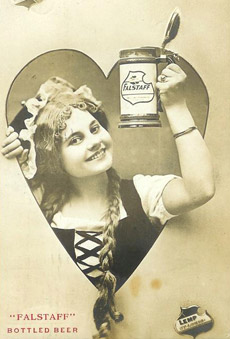Both catching up and musing . . .
– Nice interview with Jim Koch by Fortune. He says Sam Adams make flag waving, that is pointing out that every U.S. brewery larger than Boston Beer is foreign owned, part of its marketing program. Here’s the part I like.
Our destiny is to remain very small. We don’t make a mass-produced or mass-marketed beer. We make a very flavorful beer that really only appeals to 5% of beer drinkers. If we were a car we’d be a Porsche. Everyone is familiar with it, but the market share is probably what ours is.
He’s talking about Sam Adams, of course, but for “we” substitute “Goose Island” or “Berkshire Brewing” or “Boscos” and the thought is as valid.
 – Both Jay Brooks and Maureen Ogle are commenting on a Slate article “And the next great American beer will be…?” Hop you can follow all those links.
– Both Jay Brooks and Maureen Ogle are commenting on a Slate article “And the next great American beer will be…?” Hop you can follow all those links.
That’s good enough excuse to play the nostalgia card and include this old Falstaff advertisement. I pretty much agree with what Jay has to say and with Maureen’s take on the silly Schlitz revival.
But I disagree with the notion Budweiser (or Bud Light), Miller and Coors are not American beers. Have they changed from when they were made at breweries fully owned by Americans? Are they not still brewed by American workers?
– Todd Ashman of FiftyFifty Brewing in California has organized a different sort of collaboration. In other projects brewers get together and make a beer at one or the other’s breweries. Like this one.
Concentrated Evil will be something different. Ashman first brewed the strong, dark Belgian-inspired beer made with raisins, exotic sugars and aromatic spices at FiftyFifty. Then he shared the recipe with Zac Triemert of Lucky Bucket Brewing in Nebraska and Matt Van Wyk of Flossmoor Station Brewing in Illinois.
This is like “indentic-ale” projects among regional breweries (Eugene, Chicago-area breweries, New Mexico breweries to name three) where brewers used the same recipe and sometimes the exact same ingredients (except for water) to make a beer. But in this case the breweries are in California, Nebraska and Illinois.
Problem is, how could anyone easily compare the results? Here’s the really good news for those who will be at the Great American Beer Festival in October. All three versions will be available in Denver.
This should be a great opportunity to debate the importance of “where” in the beer versus (or should that be plus) what the brewer adds. Heredity versus environment, anybody?
– Angel’s Share from Lost Abbey was chosen as the best American cask-conditioned beer at the Great British Beer Festival. No surprise (I’ve already written enough about the beer), but a here’s what Andy Benson, manager of the Bieres Sans Frontieres bar, had to say: “American beers are often a surprise to the British palate, they are so intensely flavored that most people either love them or hate them, nothing like the insipid lagers we usually associate with America.”
– It appears the way is clear for Bell’s return to Illinois. That’s a good thing, because Bell’s has been an important part of Chicago becoming a better beer town, and Chicago was essential to Bell’s “early” success. I put early in quotes because Larry Bell’s brewery was hardly an overnight success.
Ha! Good post. So its like nature vs. nurture for beer? I think each brewer adds a little of his or her own magic, even if the ingredients are exactly the same!
Do you think Sam Adams and other “craft brewers” will be able to remain “small” over the next couple decades? Sam Adams will certainly be growing, probably up to and over 10 million bbl a year, don’t you think? New Belgian, Sierra Nevada, Deschutes etc. will also certainly have their eye on the million bbl mark and probably pass it sooner than later.
Small is nice, but bigger is better to make money. And…the market for craft beer continues to grow, though I doubt Double IPAs will ever have a 20% share. But Boston Lager? SNPA? Mirror Pond? Fat Tire? Sure. And more probably… And I think it’s pretty clear that the industry will track the market closely and that instead of more small brewers providing supply, the bigger will get bigger and we’ll see some intense consolidation.
Bell’s has in fact already returned to Chicago – I’ve already bought and polished off a case of the Oberon. But if you knew where to go, you could buy on tap some “Kalamazoo Brewing” beer before then.
As Larry himself has put it, Fauxberon. Though faux, it barely was! 🙂
Matt – I don’t think consolidation works when you have truly unique beers, often produced in very small quantities. For instance, Moonlight or Jolly Pumpkin.
But yes, Deschutes and New Belgium will continue to grow. So will breweries at the next level – New Glarus and Bell’s. But I think there will be room for the genuinely small as well.